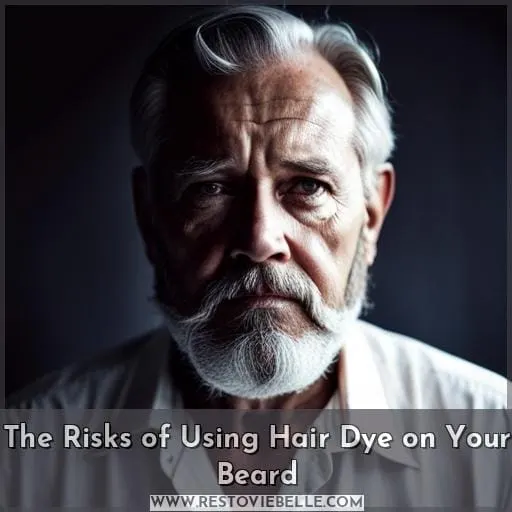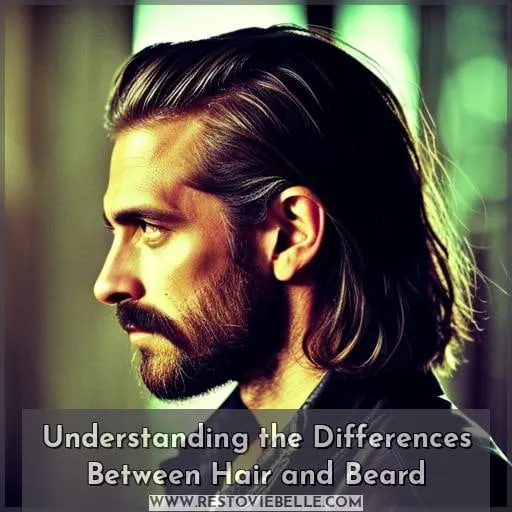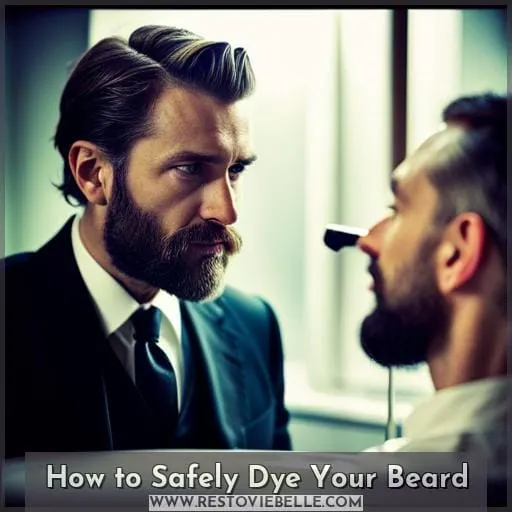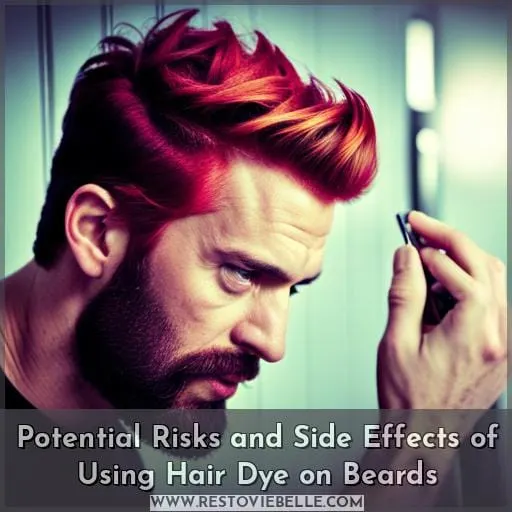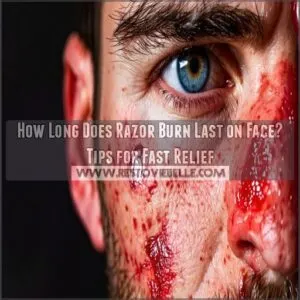This site is supported by our readers. We may earn a commission, at no cost to you, if you purchase through links.
 Longing for a more youthful look? Tired of the grey hairs in your beard making you look older than you are? While it’s perfectly okay to embrace these changes, there is nothing wrong with wanting to conceal them.
Longing for a more youthful look? Tired of the grey hairs in your beard making you look older than you are? While it’s perfectly okay to embrace these changes, there is nothing wrong with wanting to conceal them.
But before reaching for that bottle of hair dye, take a moment and consider if this is really the best option.
Can I use hair color on my beard safely? The answer can be yes – but only if done properly and with caution.
Table Of Contents
Key Takeaways
- Considerations before using hair dye on your beard
- Risks of using hair dye on facial hair
- Importance of patch testing
- Need for specialized dyes for beards
The Risks of Using Hair Dye on Your Beard
Using hair dye on your beard can be risky, as it may contain harsh chemicals that can cause skin irritation. Additionally, since facial hairs are coarser than scalp hairs, they require specialized dyes to achieve the desired results – luckily, there are many products available specifically designed for coloring facial hair.
Sensitivity to Dye Chemicals
When dyeing your beard, you need to be aware of potential sensitivity to the chemicals in the product. These can cause irritation and discomfort, leading to allergic reactions or skin damage.
Patch testing is essential for identifying any sensitivities before use. To reduce risk further, use gentle products designed specifically for beards and utilize skin precautions such as Vaseline or moisturizer when applying hair dye on your facial hair.
Beard health should always come first with these types of treatments; take care not only during application but also post-treatment by avoiding harsh environments and using oil-based products afterwards if needed.
By being mindful of potential risks associated with using hair color on your beard, you’ll ensure that its health remains intact!
Coarser Beard Hair
Beard hair is naturally coarser than scalp hair, making it more difficult to achieve even color when using traditional dyes. But with the right product and application process, you can still get a natural-looking result that lasts.
When dyeing facial hair, choose a product specifically designed for beards as they’re gentler on coarse gray hairs. Select the correct color based on your natural hair and desired look while protecting the skin with Vaseline or moisturizer.
Techniques such as cleaning the beard before applying dye, then rinsing it off after, will help ensure success in achieving desired results without skin irritation or damage to both the beard and face areas caused by permanent dyes.
Follow all instructions carefully, including patch tests, for safe use of any type of dyestuff – from professional jobs to at-home kits – whenever coloring your beard!
Availability of Better Beard Dyes
Fortunately, there are now better dyes specifically designed for beards that give you a more natural look and feel. Color matching is easier, and the application process doesn’t take as long or require special skills.
There are also product recommendations to help you find just the right one for your beard type.
Allergy testing may be necessary if using hair dye on your beard, so it’s important to pay attention to any potential signs of irritation or discomfort when using these products.
Understanding the Differences Between Hair and Beard
If you are considering dyeing your beard, it is important to understand the key differences between hair and beards. Hair texture can vary greatly from coarse to fine depending on its structure and growth pattern.
Beards, on the other hand, tend to have a coarser texture with thicker strands that may require more color retention for longer-lasting results than those of regular hair dye. Moreover, fading or uneven coloring may occur if not properly monitored during the application process due to their unique properties.
Hair Structure and Growth Patterns
Comparing your hair and beard, you’ll notice distinct textures and growth patterns – the former soft like silk, the latter coarse as sandpaper. Hair grows continually while beards are much slower; it requires more maintenance to keep them looking neat.
When dyeing a beard, consider its structure: color needs to penetrate deeply into coarser hairs for lasting effects.
Beard Texture and Thickness
Your beard’s texture and thickness greatly differ from the hair on your head, making it important to choose a dye specifically designed for facial hair. Coarser and denser than scalp hairs, beards require more attention when grooming or coloring.
Aesthetic-wise, you’ll want to match the color of your facial hair with that of your scalp too. When selecting a product for this purpose, make sure it is gentle enough not to cause irritation or damage either type of follicle.
Permanent dyes should generally be avoided due to potential skin reactions; instead, opt for semi-permanent solutions that last 3–6 weeks. These solutions provide excellent coverage and blending ability without posing any risk of harm.
Proper application techniques are essential in keeping both beard hairs and skin safe during this process as well!
Color Retention and Fading
When contemplating using hair color on your beard, it’s important to consider the potential for fading and retention of color. Color longevity depends on a variety of factors such as dyeing frequency, maintenance tips, and prevention methods.
Choose a quality product that is specifically designed for beards. This will help reduce damage to the skin or irritation caused by harsh chemicals from regular hair dyes. To maintain optimum coloring results between applications, use natural oils in conjunction with gentle shampooing practices that are suitable for facial hairs.
Avoid overexposure to environmental elements like sunrays or chlorine pools, as they can cause fading prematurely.
Taking these steps into consideration when selecting an appropriate beard care routine helps ensure longer-lasting vibrant colors while avoiding unnecessary damage or skin irritation due to frequent dyeing cycles.
Types of Dyes and Their Suitability for Beards
When it comes to dyeing your beard, there are a variety of dyes available for you to choose from, depending on the desired result. Permanent hair dyes provide long-term color and coverage until you shave or trim your beard; semi-permanent dye lasts 3-6 weeks; temporary colors offer minimal staining and wash out in one wash; while natural and organic dyes are non-toxic alternatives.
Permanent Hair Dyes
Permanent dyes offer a longer-lasting solution, with color that can last up to 8 weeks or more – significantly longer than the 3-4 days of semi-permanent dye. However, you must take extra care when using permanent hair dye for your beard. Improper application and aftercare can lead to skin irritation and damage to both your beard hairs and skin.
When selecting a color, make sure it matches the natural hue of your facial hair. Take into account its coarser texture compared to head hair. Always follow package instructions precisely during application to ensure even coverage from roots all the way down through your tips.
Afterward, make sure you use oil-based products occasionally for proper moisturization. This will prevent fading or bleeding instead of harsh environments, which can accelerate discoloration over time.
Semi-Permanent Hair Dyes
Semi-permanent dyeing is an ideal option for those seeking a long-lasting, natural look with less commitment. It offers color retention that’s better than temporary dyes but requires more frequent touchups.
The coarse texture of facial hair can make it difficult to apply the dye evenly and prevent skin irritation from beard dye, so be sure to use products specifically designed for beards. Natural options like henna are also available as safer alternatives with fewer risks of using hair dye on your beard.
To ensure safe application and optimal results, always follow package instructions and consider professional help if necessary.
Temporary Hair Dyes
If you’re looking for a quick touch-up to cover gray hairs in your beard, try temporary dye—it’ll give you lasting color without the commitment. Temporary dyes are easy to use and provide great benefits, such as being non-toxic and causing less damage than permanent dyes.
However, it’s important to match colors correctly since they don’t last very long. When applying, wear gloves and apply petroleum jelly on skin areas that may come into contact with dye.
For best results, maintain your beard regularly. Wash it thoroughly prior to application or use oil-based products after dyeing for optimum protection against environmental factors like sun or wind exposure that can cause the color to fade quickly.
It’s also helpful when removing stains from the skin caused by temporary hair dye on beards.
Natural and Organic Dyes
For a more natural look, opt for natural and organic dyes that are free of harsh chemicals. DIY options include coconut oil, lemon juice, or chamomile tea to color your facial hair without the risk of skin irritation from beard dye.
Even when using store-bought products for safe beard coloring, there are many types of hair dyes available specifically meant for beards that use organic solutions and provide better results than standard permanent colors.
To safely dye your beard with any product, it’s important to follow the instructions carefully while taking extra measures like protecting the skin with Vaseline or moisturizer before application.
With proper preparation and care after the dying process is complete, you can enjoy a beautiful result in no time!
How to Safely Dye Your Beard
Before you decide to dye your beard, it is important to properly prepare your facial hair by cleaning and trimming it. Additionally, selecting the right color and type of dye for your skin tone and desired look will help ensure a successful application process.
By following these steps, as well as taking proper aftercare precautions, you can safely achieve a natural-looking colored beard that lasts for weeks or even months.
Preparing Your Beard for Dyeing
Before dyeing your beard, proper preparation is key for optimal results. Start by washing and conditioning the beard with a shampoo specifically designed for beards. Trim any areas that are longer than desired to ensure even application of the chosen color product.
Carefully select hair dye that is formulated specially for use on facial hair; permanent or semi-permanent dyes work best, as they offer more natural-looking results than temporary dyes do. Use a skin barrier such as Vaseline or moisturizer before applying to protect against staining and irritation from chemicals in the product.
Test out colors on an inconspicuous area first to get an idea of what it will look like after dying if you’re unsure about which shade would work best with your natural coloring—this ensures you’ll be happy with how it looks once finished!
Choosing the Right Color and Dye Type
Selecting the suitable shade and dye type is essential for achieving a stylish, natural-looking beard. When choosing color, make sure to match it with your hair or desired look. Permanent dyes last until shaved off, while semi-permanent usually last 3–6 weeks.
For safety reasons, use products specifically designed for beards. They are gentler on coarser gray hairs and tend to cause less irritation than regular hair dye products. To avoid mistakes in application, follow package instructions carefully. Protect your skin by using petroleum jelly as a barrier against staining or irritation from fade-out results.
Before applying the product, make sure to apply it evenly from the roots to the tips of your facial hair strands. Beard maintenance afterwards is also important to achieve the best possible result with minimal risk of damage due to harsh environmental exposure or improper usage of oil-based products afterward.
Step-by-Step Beard Dyeing Process
Now, follow the steps to apply dye evenly and get a natural-looking color! Before you start, make sure to choose the right dye color based on your natural hair color.
Follow with proper beard maintenance by cleaning, trimming, and using beard shampoo.
Wear gloves and use petroleum jelly as a skin barrier before application. Apply the dye from roots to tips, following the package instructions.
Rinse with lukewarm water afterwards and then avoid harsh environments while caring for dyed facial hair with oil-based products.
Aftercare and Maintenance
After dyeing your beard, keep it looking great with regular maintenance and aftercare. A stitch in time saves nine: use oil-based products for the best results, avoid harsh environments to maintain a healthy shine, and create a proper post-dye care routine.
For lasting color without the risk of skin irritation or damage to facial hair and skin from dyeing, focus on beard color longevity with careful upkeep – this includes avoiding fading caused by uneven application or lack of maintenance.
Potential Risks and Side Effects of Using Hair Dye on Beards
Dyeing your beard can be a great way to conceal gray hairs, match it with the color of your hair, or simply express yourself. However, there are some potential risks and side effects involved in using hair dye on beards that you should consider before taking the plunge.
These include skin irritation and allergic reactions, uneven color and patchiness, as well as damage to both beard hair and skin. Knowing these ahead of time will help you make an informed decision about whether dyeing is right for you.
Skin Irritation and Allergic Reactions
Before you grab that dye bottle, be aware of the potential risks and side effects associated with using hair color on your beard. Skin sensitivity or allergic reactions are possible if you do not patch test prior to application.
It is recommended to use a product specifically designed for facial hair, as it has a coarser texture and can help avoid skin irritation from beard dye. Proper care must be taken during application to prevent damage to both your hair and skin.
This includes avoiding excessive exposure during application and following post-treatment maintenance instructions. When selecting products, performing a patch test, and following directions carefully, you can minimize the risk of unwanted damages from using hair dye on beards.
Uneven Color and Patchiness
Despite following the instructions, you may find your beard dye application leaves an uneven color with patches of gray still visible. To avoid this, make sure to select a product designed specifically for beards and that matches your natural hair color.
When dyeing, take into account differences in texture between facial hair and scalp hair and use appropriate techniques. For example, apply petroleum jelly around the skin or use a conditioning treatment prior to coloring.
As part of a regular maintenance routine for dyed beards, use specialized oil-based products to prevent fading or patchiness from occurring over time.
If mistakes are made when dying your beard at home, it is best practice to consult professional help for removal instead of attempting DIY solutions. There are excessive risks associated with these methods, including causing damage to both the skin surface area and the hairs themselves.
This can lead to potentially irreversible effects on growth patterns down the line if not managed properly by experienced personnel familiarized with all types of dyes available in the market today.
Damage to Beard Hair and Skin
When dyeing your beard, you risk damaging both the hair and skin if not done correctly. Skin sensitivity can be an issue when using hair dyes on the face. The texture of beard hairs is much coarser than that of head hairs, which requires a different type of product for optimal results.
Additionally, matching colors between facial hair and scalp can be difficult due to skin tone differences. Improper application techniques as well as insufficient aftercare tips may lead to patchiness or uneven coloration in areas with thinner density growths present on the face such as temples or sideburns.
To avoid any potential damage from occurring, it’s important to seek professional advice before attempting this process at home and follow all instructions provided by chosen products carefully!
Conclusion
Dyeing your beard can be a great way to conceal graying hairs or match your facial hair to the color of your hair. However, it’s important to understand the differences between hair and beard to ensure a safe dyeing experience.
Permanent dyes should be avoided for beards because they can irritate the skin and damage the beard. On the other hand, semi-permanent and temporary dyes are gentler and provide better color retention.
Natural and organic dyes are also a great option as they are non-toxic and less likely to cause skin irritation.
With the right preparation, dye selection, and aftercare, you can safely use hair dye on your beard and achieve the desired look.

